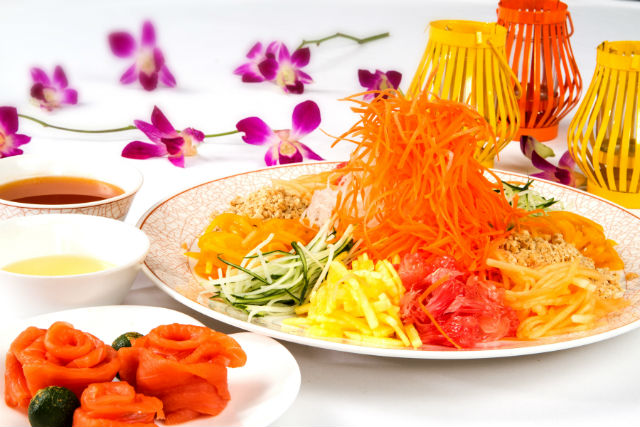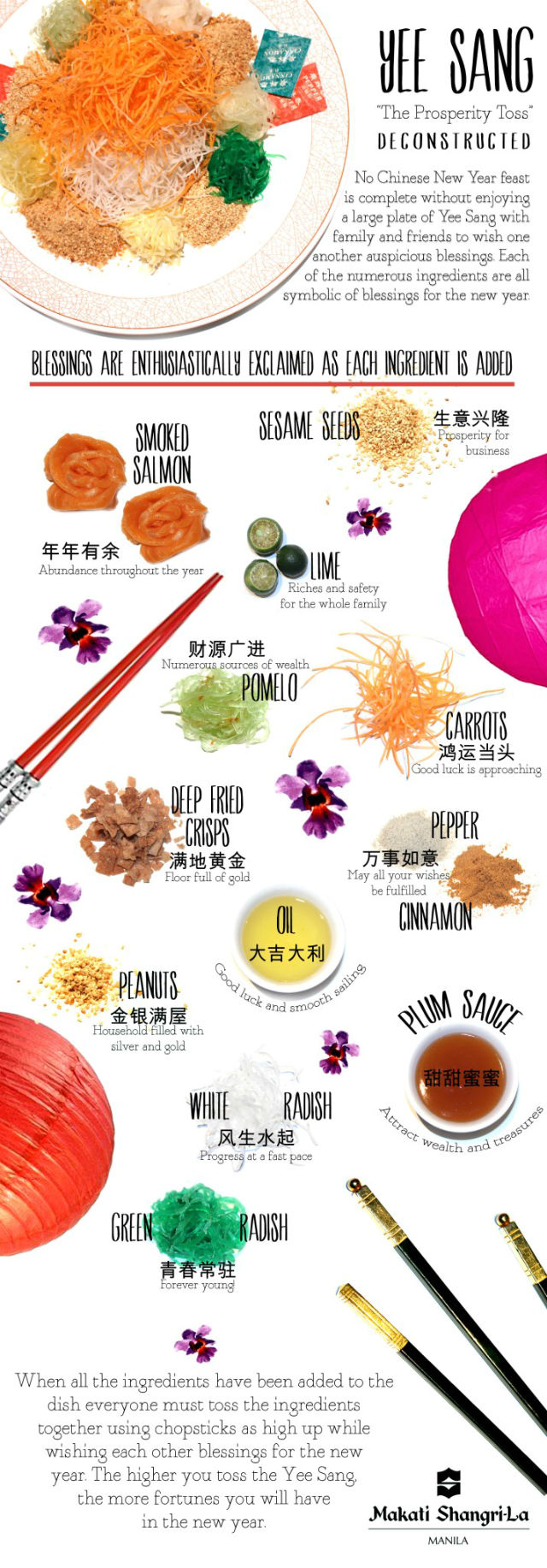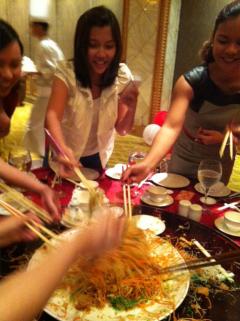Filtered By: Lifestyle
Lifestyle
Toss your food for luck in the Year of the Snake
By AMY A. UY
How does throwing your salad up in the air get you a year’s worth of luck and prosperity?
That’s the question after everyone at the round dining table has enthusiastically tossed the good luck food high up in the air with their chopsticks, leaving a big mess and less food on the serving platter.
This modern Chinese tradition is called the Prosperity Toss (Yee Sang or Yu Shang), meant to usher in wealth and prosperity in the coming Lunar Year. Yee Sang is also the name of the dish that was said to have originated in China but became a big part of the Chinese New Year festivities in Singapore in the sixties.

This modern Chinese tradition is called the Prosperity Toss (Yee Sang or Yu Shang), meant to usher in wealth and prosperity in the coming Lunar Year. Photo courtesy of Makati Shangri-la
If you go by how prosperous today’s modern Singaporeans are, then there’s no doubt that this Prosperity Toss does work.
The Yee Sang may not be part of the traditional lauriat that families partake of during Chinese New Year’s eve but it has become a welcome addition to the restaurant menus in Singapore since the 1960’s when it was first introduced as a starter.

Yee Sang salad is made with 27 ingredients. Photo courtesy of Makati Shangri-la
Yee Sang salad at the Makati Shang Palace
Here in the Philippines, Yee Sang has become a major part of the Chinese New Year menu served at the Makati Shangri-La Hotel’s Shang Palace.
Yee Sang is actually a salad with 27 ingredients that includes raw fish strips, such as salmon, mixed with shredded vegetables, sauces, condiments and other ingredients chosen for the meanings they denote such as riches, success, youth and vitality.
The main ingredient is fish which symbolizes abundance throughout the year. Then there are carrots for good luck, pomelo for wealth, sesame seeds for prosperity in business, lime for riches and safety, pepper and cinnamon for wishes fulfilled, peanuts for silver and gold, white radish for progress, green radish for youth, deep-fried crisps for a floor of gold. There’s also plum sauce for flavoring to attract treasures and of, course, oil to swirl the good fortune around and for smooth sailing all year.
All the colorful ingredients are aesthetically arranged on a large round platter then mixed together. At this point, everyone at the table must be ready with their chopsticks. Not to eat but to first toss the salad up in the air.
Higher toss means more money
“The higher you go, the more money for your pocket,” says Makati Shangri-La’s executive chef Richard Thong, himself a Singaporean.
Chef Richard also shared that the hotel restaurant’s version of the Yee Sang uses ingredients imported from Singapore like the green raddish which is actually wintermelon that’s been soaked in sugar syrup for a couple of years. That’s not something you can pull out of a supermarket shelf here.
He also shared that the Yee Sang was a dish tailor-made to cater to the multi-racial population of Singapore so even Indians and Malays, with their rigid diets, could join the Chinese New Year celebrations.
It is interesting to note, too, that all the ingredients are raw or uncooked which means that everything in the salad is fresh, perhaps to signify a fresh start for the new year.

The prosperity toss in action. Photo by Amy A. Uy
After the Yee Sang was laid on the table and on the prodding of Chef Richard, everyone in our group joined in the animated food-tossing while shouting auspicious sayings for luck like “Nian Nian You Yu!” (abundance throughout the year), “Da Ji, Da Li!” (good luck and smooth sailing) or even just the familiar “Gong Xi Fa Cai!”
Of course, saying these wishes in English are also accepted and suggested, lest you make a mistake in uttering the phrases and you end up with the reverse of good luck.
Don’t fret if your too-eager food-tossing results in a huge heap of mess on the table. That could mean more luck for everyone. Get two servings of the Yee Sang from the platter and have fun savoring the sweet and sour taste of the plum sauce on the vegetables. With slices of lime-drizzled smoked salmon, the salad is surprisingly refreshing and light. And the deep-fried crisps, like chips, give it a salty and crunchy bite.
More dishes seal the prosperity deal
In Makati Shangri-la’s Lunar New Year menu, the Yee Sang is usually followed by more dishes to seal the prosperity deal: noodles for a long, good life, assorted dimsum (har gau, xiao long bao, and barbecued pork pies), dry oysters encased in a tofu skin that’s shaped like a money bag and the lucky fish, steamed lapu-lapu with its soft and sweet meat in a light soya sauce.
Towards the end of the meal, Fried Rice with Chinese Sausage is served, wrapped in a lotus leaf. The rice which is fried with eggs and Chinese sausage bits and flavored with oyster and soy sauces, is wrapped and steamed inside a lotus leaf that lends the faint smell of tea. In a proper lauriat, rice is served last, to allow the guests to enjoy the best food first.
For dessert, the celebration ends with sticky tikoy in classic, coffee and coconut flavors; pineapple cakes; and velvety egg tarts.
Yee Sang and the whole idea of tossing food in the air for luck might be rather new to us but as we are a superstitious lot, the tradition will most likely catch on soon.
Just as we Pinoys now casually and merrily greet each other “Gong Xi Fa Cai!” while joining the festivities, hanging on to the promise of luck and a better life that a new year brings. – KDM/KG, GMA News
More Videos
Most Popular




